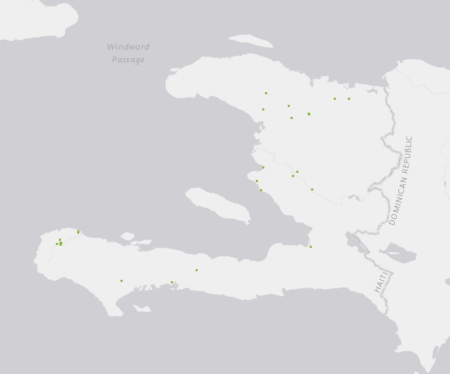- “It is like archaeology to me. When you save an ancient seed it is like saving a sculpture. It represents the culture, tradition and history. Different types have different traits and intense flavours, like tomatoes years ago for example.”
- Vietnamese specialty rices direct from the genebank. Totally unrelated to this NY Times video-essay on Hmong rice farming.
- Time for tea.
- Making coffee good again. Jeremy explores fair trade and Fair Trade. Do tea now, please, Cherfas.
- ‘Shrooms got magic horizontally, man.
- Why do circus peanuts taste of bananas?
- Bringing back the mouse bean. Which may or may not taste of bananas.
- Cool maize book to round off the Native American crops trifecta.
- Oh no, here’s another one. Pinning down maize domestication.
- Funky ICARDA agroclimatological app.
- REALLY old Italian wine. And something to go with it.
- ICRISAT has a genebank in Zimbabwe too.
- Plant Treaty transfers hit a milestone.
- Policy brief on policy briefs. Homework: do a killer policy brief on any of the above.
Nibbles: Seed saving, Craft saving, Talking sweet potatoes, Breeding eggplants, Cat domestication, Cary on Svalbard, US apple book, US strawberries, Forages newsletter, Banana double
- 94% is the new 75%. Here’s some of the survivors.
- But how many crafts have we lost?
- Win a prize for communicating about sweet potatoes.
- Pre-breeding eggplants using their wild relatives.
- Two waves of cat domestication.
- Svalbard double.
- 350 buck’s worth of apple history.
- 10 cent’s worth of strawberry history.
- Latest newsletter from those nice forages genetic resources conservation folks.
- Bananas good and bad news.
Brainfood: Wild foods, Maize in Guatemala, Wild lentils, Sorghum gaps, Ethiopian erosion, Chikanda barcoding, Brazil nut systems, Wild carrots, Ancient wild potato use, Wild wheat grains
- The role of wild fruits and vegetables in delivering a balanced and healthy diet. Not great, until they’re domesticated.
- Maize Diversity, Market Access, and Poverty Reduction in the Western Highlands of Guatemala. Forget maize.
- Evaluation of Wild Lentil Species as Genetic Resources to Improve Drought Tolerance in Cultivated Lentil. Environment explained drought response in wild lentils better than molecular classification.
- Geographical distribution, diversity and gap analysis of East African sorghum collection conserved at the ICRISAT genebank. Both Sudans.
- Explaining the Ethiopian farmers’ perceptions on potential loss of traditional crop varieties: A principal components regression analysis. Poor farmers know more, and care more, about loss of traditional landraces.
- High-throughput sequencing of African chikanda cake highlights conservation challenges in orchids. Those are very biodiverse cakes, but not in a good way.
- Revisiting the ‘cornerstone of Amazonian conservation’: a socioecological assessment of Brazil nut exploitation. It’s actually in pretty good shape, but that doesn’t mean it can’t be improved.
- Phylogenetic Prediction of Alternaria Leaf Blight Resistance in Wild and Cultivated Species of Carrots. Look for taller material in clade A.
- Starch granule evidence for the earliest potato use in North America. S. jamesii may have been used for 10,000 years in Utah.
- Genome-Wide Association Study of Grain Architecture in Wild Wheat Aegilops tauschii. Two genetic lineages, with big differences in grain width and weight.
Brainfood: Taste breeding, Cat domestication, ITPGRFA in USA, CWR extravaganza, Ecology & ag, Brassica identification, Biodiversity monitoring, Languages, Species recovery, Benin pigeonpea
- Sensory sacrifices when we mass-produce mass produce. You need consumer-assisted selection.
- The palaeogenetics of cat dispersal in the ancient world. Two Middle-Eastern sub-populations of one sub-species contributed to domestication, at different times, and the result spread first with agriculture and then aboard ships. But we haven’t changed them in the same way we’ve changed dogs etc. You don’t say.
- U.S. ratification of Plant Treaty: benefit sharing ambiguity for plant genomics researchers does not change. But what about genomics data?
- Wading Into the Gene Pool: Progress and Constraints Using Wild Species. Introduction to the Special Section on CWR.
- Plant ecological solutions to global food security. Introduction to the Special Feature on Ecological Solutions to Global Food Security. The intersection with the above is probably here.
- A multiplex PCR for rapid identification of Brassica species in the triangle of U. Now there’s no excuse.
- Connecting Earth observation to high-throughput biodiversity data. I don’t see any reason why the same thinking couldn’t be applied to crop diversity.
- Linguistic diversity of natural UNESCO world heritage sites: bridging the gap between nature and culture. 80% of Natural WHSs intersect at least one indigenous language.
- Overcoming barriers to active interventions for genetic diversity. Embrace the hybrid by focusing on process, not form.
- Utilization and farmers’ knowledge on pigeonpea diversity in Benin, West Africa. For some reason, farmers don’t like coloured seeds.
Maize for Haiti; but from Haiti?
Good news for hard-pressed Haitian farmers.
The International Maize and Wheat Improvement Center (CIMMYT) has grown 150 tons of renewed, improved maize seed that will be sent to Haitian farmers to help jump-start the country’s seed sector, improve local food security and decrease malnutrition. This will be the largest seed shipment to any country in CIMMYT’s history.
But are there any maize landraces left in Haiti that this much-needed effort will displace? If so, it will be important to collect them. Genesys lists 78 landraces from the country, most at the genebank of CIMMYT itself, collected thus:

Maybe enough. Maybe not…